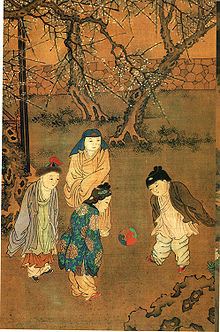Cuju
[1][2] FIFA cites cuju is the earliest form of a kicking game for which there is documentary evidence, a military manual from the Han dynasty.
Descriptions of the game date back to the Han dynasty, with a Chinese military work from the 3rd–2nd century BC describing it as an exercise.
[9] During the Han dynasty (206 BC – AD 220), the popularity of cuju spread from the army to the royal courts and upper classes.
A type of court called ju chang (鞠場) was built especially for cuju matches, which had six crescent-shaped goal posts at each end.
The Tang dynasty capital of Chang'an was filled with cuju fields, in the backyards of large mansions, and some were even established in the grounds of the palaces.
[13] Soldiers who belonged to the imperial army and Gold Bird Guard often formed cuju teams for the delight of the emperor and his court.
[13] Cuju flourished during the Song dynasty (960–1279) due to social and economic development, extending its popularity to every class in society.
Scoring goals became obsolete when using this method with the playing field enclosed using thread and players taking turns to kick the ball within these set limits.
According to Dongjing Meng Hua Lu, in the 10th century, a cuju league, Qi Yun She (齊雲社) was developed in large Chinese cities.

